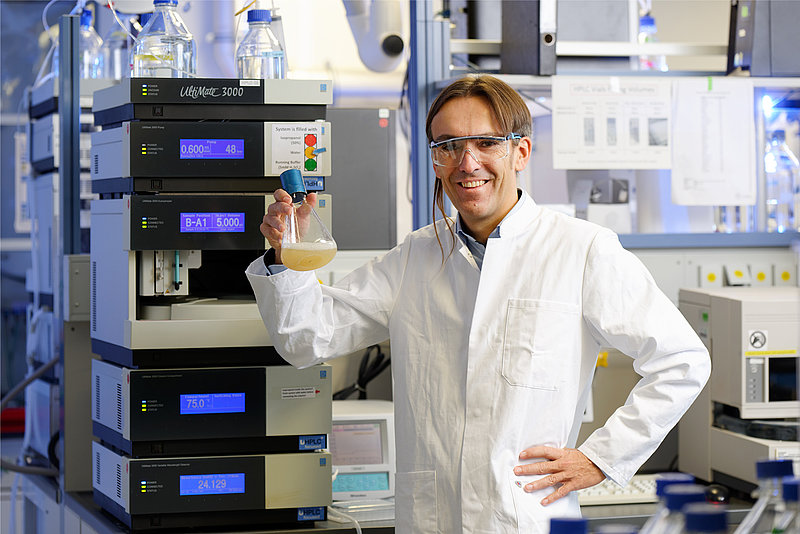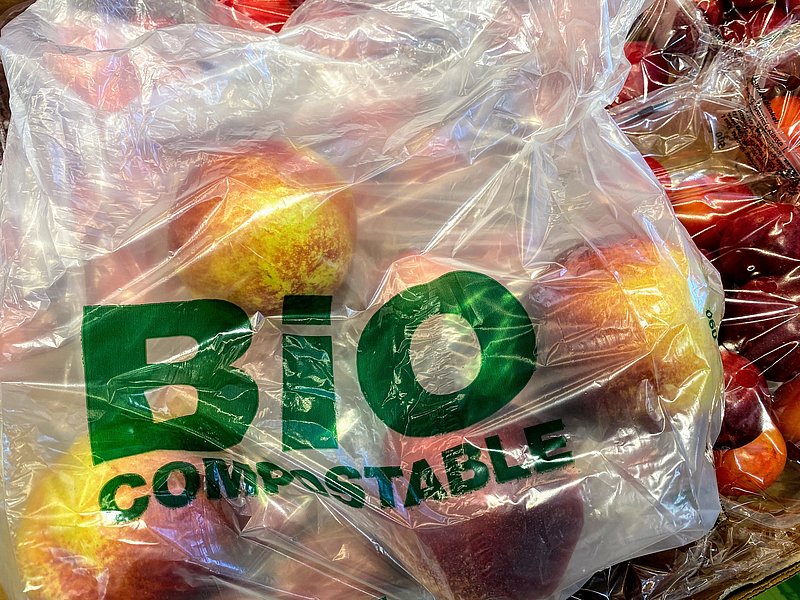"I Am Absolutely Convinced that Biobased Plastic Is a Solution"
With the trend towards sustainability, bioplastics are also becoming increasingly popular. Plastic cutlery made of corn starch or garbage bags made of lactic acid - supposedly sustainable plastic is finding its way into our supermarkets. But this is also attracting critics. They argue that biodegradable plastics are a mistake and a waste of resources. We have asked Professor Lars M. Blank, head of the iAMB institute and project coordinator of MIX-UP, to give us an interview on what bioplastics are and why opinions differ so much.
Mr. Blank, you probably know that situation: You order a drink in a restaurant in the evening and get it served with a straw, which becomes softer the longer it stays in the drink. The reason: it is made of corn, bioplastics. If you had a choice, would you rather use the conventional straw or the organic straw?
Blank: Yes, I know the situation. But in the restaurant I can only think of the cocktail. That's why I find it difficult to drink it without a conventional straw because the organic variant doesn't last long enough.
With straws there are now many variants. From your point of view, which one is currently the most sustainable straw variant in terms of the eco-balance?
Blank: Well, for a canteen kitchen with professional dishwashers it is certainly the reusable straws, because they can be used and cleaned on a large scale. Otherwise, cleaning is not reasonable regarding to the ecological balance. We know this from the PET bottle: depending on the distance, the energy consumption for cleaning and transport is significantly higher with the reusable alternatives. Nevertheless, I think that we can - and should - completely do without straws for most beverages. Today, every child in a restaurant is given a straw. This is completely unnecessary.
In many other areas it is much more difficult to do without plastic. Bioplastics gradually slide into our everyday life. What exactly is the difference to conventional plastic when we still call it "plastic"?
Blank: Bioplastics is not so easy to explain. First of all, I make a differnce between two categories: "bio-based" and "biodegradable". The former means that the carbon source is not based on a fossil resource like crude oil, but on renewable resources like sugar cane or directly on CO2, carbon dioxide. "Biodegradable", on the other hand, says nothing about the resource or where the carbon comes from, but only that it can be broken down biologically, which means that it can be decomposed by microorganisms and their enzymes. But there is another aspect: bioplastics, which are produced biotechnologically by microorganisms. The most widespread polymer here is lactic acid, which we find more and more in plastic sheets. It is biological because the lactate is produced by microbes that convert sugar from sugar cane or corn into lactate, for example. The lactate is then converted into polylactate in a chemical process. As consumers, we don't necessarily notice this; the transparent film around our food can be made of bioplastic or conventional plastic.
Critics argue that bioplastics take away land for growing food. In addition, they say, it uses more fertilizers and pollutants, than conventional plastic, such as pesticides which pollute the soil and groundwater. Even the BUND, a German non-governmental organization, has once written: "Biodegradable plastics made from renewable raw materials are an aberration". What is your opinion on this?
Blank: I do not understand that at all. What is the alternative? If the alternative is that we always need fossil resources, we have a problem of understanding. For me, the goal must be that we ideally freeze the concentration of CO2 in the atmosphere soon and then reduce it again, so taking CO2 out of the atmosphere. If we say that biodegradable plastics are a mistake, we are wasting an opportunity. We already produce 400 million tons of plastic, and by 2050 it will be 500 to 800 million tons. If all this is oil-based, we will have even more CO2 in the air. If, on the other hand, we extract CO2 from the air using renewable raw materials or directly by means of microbes, then we can contribute to a slower increase in CO2 at the beginning and ideally even reduce it in the future, because plastic has a very long history of use in house building, for example. In these terms plastic does not necessarily have to be biodegradable, I agree with BUND. But I am absolutely convinced that we have to go for bio-based. Every ton of crude oil that we can leave in the ground must be left there. I think it is important to question the value-added chains in bioplastics production, whether they really save CO2, including fertilizer production, so that we are not doing green washing in the future. In the case of polylactate, we have succeeded in reducing CO2 and in the near future in avoiding CO2 almost completely! Bioplastics can and will contribute to CO2 reduction. There are few products in the chemical industry that are manufactured in such large quantities. So if you can't reduce CO2 in plastics, where can you do it?
"Every ton of crude oil that we can leave in the ground must be left there."
- Professor Lars M. Blank on conventional plastics
Could the problem be avoided by producing bioplastics and conventional plastics exclusively from "waste products" like plastic waste?
Blank: Yes, that means in reverse that we don't have to use a fresh ton of crude oil anymore - we already got that out. But it is important that we do not burn more coal for recycling. Unfortunately, our energy mix is still so energy-guzzling at the moment that it will only really pay off in the future - especially in Germany with its large lignite sector. So the issue is also related to the energy transition: If we manage to achieve this, meaningful opportunities will also arise in plastics recycling. At the moment, many recycling methods do not work yet. But I am confident that we will achieve the energy transition - we can see the current figures for 2020, when renewable energies will have overtaken coal for electricity generation for the first time, and then new doors will open for recycling. In the future, this will be enough for a sensible CO2 balance, but companies must be able to earn money. As long as new plastics made from crude oil are cheaper than bio-based or recycled plastics, there will be no real contribution. What is needed, therefore, is the much discussed CO2 tax, which would make products made from new oil significantly more expensive. An alternative would be a higher oil price, but we cannot wait for that.
Now, the MIX-UP project is also about using bacteria to break down unsorted, mixed plastic waste and at the same time produce bioplastics. How can a layperson imagine this?
Blank: Let me try to explain it with an analogy: When an oak tree falls down because it is at the end of its life, it is a mixture of different components. And then a wide variety of organisms that are hydrolytically active settle on it, so that the compounds of the components can be split. At the beginning there are for example many mushrooms. They break down the components into small pieces and later into their basic building blocks. Then other microbes, such as bacteria, come along and help to metabolize this flood of different basic building blocks to use them as food and thus to reproduce. It is similar with plastic - except that a collection of plastic is in most cases not as complex as an oak. The hydrolytic activity, the splitting of the components is performed by enzymes. So we put a mixture of enzymes on it. This way chemical bonds are broken and oligomers or ideally monomers are formed - the basic building blocks, to stick to the analogy. And then we will simply filter: everything that is in the solution, all monomers, we would then give microbes that take that as a source of carbon and energy, in other words, as food. And with the solid matter that is left over at the end, we will then look to see if we can extract other valuable substances through chemical processes or bioprocess engineering methods.
Do you think that bioplastics will replace conventional plastics in the coming years? What is your opinion?
Blank: In my opinion, it has to get a big percentage. But it also depends on what you can count as bioplastics. Does bioplastics also include PE such as our plastic bag, which is made of ethanol? Does bioplastics also include a PET made from ethanol and an aromatic compound? If that is the case, then definitely yes! Because we have to make a difference at all levels, not just in energy production. Transportation, housing, but also the chemical industry must do its part to improve the CO2 balance, and plastic is one of the drivers in view of the production tons. By my definition, bioplastics would directly replace conventional plastics, namely based on the carbon source.
Mr. Blank, thank you very much for the interview!




